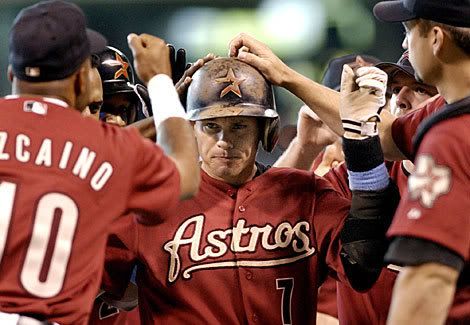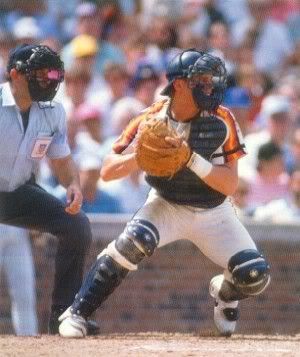 Anyone who believes Craig Biggio (pictured) wasn't worthy of entering the Baseball Hall of Fame until he achieved his milestone 3,000th career hit late last month needs to have her or his head examined.
Anyone who believes Craig Biggio (pictured) wasn't worthy of entering the Baseball Hall of Fame until he achieved his milestone 3,000th career hit late last month needs to have her or his head examined.Biggio said earlier this week that he would retire after 20 seasons of wearing only the many colours of the Houston Astros. No doubt a lot of sports journalists said or wrote gems on a theme of, "He's never won a World Series or a MVP award," to quote a very blond anchor at one of the Canadian sports networks.
Ya? And? So? What? Neither did Tony Gwynn, who is being inducted into the Hall of Fame in Cooperstown, N.Y., this very weekend. He only got 97.6% of the vote too.
Twenty players who played most of their career after the Second World War have reached 3,000 hits. The point here is that Craig Biggio brought a wider range of abilities to the game than almost any comparable player in the past 60 years who also had the staying power to reach 3,000 hits. What's special about him touches almost all areas of what a batter does to help his team score runs, which is the name of the game.
So, and this is crude, one way to do this is to compare each post-WW2 3,000-hit club member's ratio of secondary bases (extra bases on hits, stolen bases and walks) to career hits. The principle is that not every hit is created equal. A 2-for-3 game with two singles is not the same as 2-for-3 with a home run, a walk and a stolen base. This can basically be called the "Secondary Return" ("SecRet") for short. I'm not even sure if it has any value, but it should show what a player contributed on top of just getting hits.
For relevancy's sake, Henry Aaron, Rickey Henderson and Willie Mays have been omitted (I did crunch numbers for them anyways, and they're so far ahead of the other guys here that it's not even funny). Biggio's not competing against them to get into the Hall of Fame; he's competing more against the likes of Gwynn, Paul Molitor or Ryne Sandberg. Since this is about the Hall of Fame, Rafael Palmeiro has been omitted for obvious reasons.
So here's each player's ratio of secondary bases to career hits for the remaining 16 players:
- Carl Yastrzemski: 1.209
- Stan Musial: 1.152
- Dave Winfield: 1.141
- Eddie Murray: 1.101
- Al Kaline: 1.084
- Craig Biggio: 1.061
- George Brett: 1.010
- Cal Ripken: 0.989
- Lou Brock: 0.964
- Paul Molitor: 0.944
- Robin Yount: 0.899
- Wade Boggs: 0.827
- Pete Rose: 0.766
- Rod Carew: 0.759
- Roberto Clemente: 0.732
- Tony Gwynn: 0.709
Remember, the five players ahead of Biggio on that list each played first base, designated hitter or a corner outfield spot. Biggio, in fact, is the only player of the post-WW2 era to reach 3,000 hits while playing most of his games at second base, which is more demanding mentally and physically. (Rose, Carew and Molitor started out there but moved to other positions; Yastrzemski was converted to the outfield in the minors).
What's that as a percentage? Here's the career secondary averages (secondary bases divided by at-bats) for our sweet sixteen (career batting average:
- Musial: .381 (.331)
- Yastrzemski: .345
- Winfield: .323 (.283)
- Kaline: .322 (.297)
- Murray: .316 (.287)
- Brett: .308 (.305)
- Biggio: .299 (.282)
- Molitor: .289 (.306)
- Brock: .283 (.293)
- Ripken: .273 (.276)
- Boggs: .271 (.328)
- Yount: .256 (.285)
- Carew: .249 (.328)
- Gwynn: .240 (.338)
- Clemente: .232 (.317)
- Rose: .232 (.303)
It's clear, looking at this list, that batting average has import, if not actual importance. It's an easily understood touchstone between sports fans. Suppose those averages were reversed. How would fans perceive Tony Gwynn if he had a .240 career average and a .338 secondary average? He wouldn't be looked at in the same way and he probably wouldn't have been able to spend 20 years with the San Diego Padres.
Conversely, if Craig Biggio was a career .299 hitter across 20 seasons -- which would have meant he was well above .300 lifetime during his peak seasons -- there would be no doubt about it with his Hall of Fame candidacy. There's more to it in than that. This exercise probably only has value if you're comparing similar types of players who played about the same number of seasons. It also doesn't take into account era or home-ballpark factors.
There's more to it in than that. This exercise probably only has value if you're comparing similar types of players who played about the same number of seasons. It also doesn't take into account era or home-ballpark factors.
Also, we're only looking at career stats. Ballplayers should be judged based on a their peak period across 10 or 12 years. That's why this was limited to 3,000-hit club members, who do take a hit on their "percentages" to get the hallowed milestone. The most infamous was Kaline, who was a .300 hitter all his life until his final season, 1974, when he came back in a bid to reach 3,000 hits and 400 homers (he ended up at 399).
For instance, Sandberg, the great Cubs second baseman who went into the Hall of Fame on the first ballot in 2003, played "only" 16 seasons with 2,386 career hits.
Guess what? His Secondary Return for his career was 1.050, lower than Biggio's 1.061. The gap is only that close due to Sandberg's early retirement(s) and Biggio spending 11 seasons as an everyday player with the Astrodome as his home ballpark. (Biggio had a higher on-base plus slugging, or OPS, on the road in eight of his 11 seasons as an everyday player where the Astros played indoors.
How about Biggio's other 1990s contemporary at second base, Roberto Alomar, who retired on a career .300 batting average after 17 seasons and 2,724 hits? Alomar's "Sec Ret" is 1.028.
Using Secondary Ratio and looking at secondary bases should show how Craig Biggio's essence as a ballplayer spread across so many facets of the game and elevates him to the class with Gwynn, Alomar, Sandberg and Cal Ripken, who's also entering Cooperstown this weekend. It's not that he was better. It's just most of the others had something defining -- Gwynn's .338 average, Ripken's consecutive-game streak -- that has import, but isn't the be-all end-all.
He could get on base (career .365 on-base percentage), he could score runs (12 seasons with 94 or more runs scored), and he hit with exceptional power for a second baseman (he's the all-time leader in doubles among right-handed hitters, and had more than 300 homers). Did I mention he started his career as a catcher?
We haven't even touched on his mastery of the little things. If we added in hit-by-pitches into these comparisions, Biggio, who has been plunked a record 285 times, would come out even better. Remember who people talk about Gwynn's bat control? Well, Biggio has come to bat some 2,000 times more than Gwynn did and he's hit into 111 fewer double plays. What does it say when Biggio has been that much harder to double up than the guy who was reputed to have the best bat control of any player in the past 50 years?
It's all in how people orient their thinking about a ballplayer, and it's obvious if people did it better, Biggio's Hall of Fame worthiness would have been a given long before he got his 3,000 hits. At the very least, it wouldn't have taken until 2007 for the reality to dawn on very blond Canadian sports anchors.
Related:
Jeff Bagwell: Early Adopter And First-Ballot Hall of Famer (Nov. 1, 2006)
That's all for now. Send your thoughts to neatesager@yahoo.ca.






2 comments:
Is "secondary ratio" actually a statistic or did you just basically take the ingredients of OPS and add stolen bases to it?
That's basically it, the "elements of OPS." It's extra bases (total bases minus hits), walks (which go into OBP) and then stolen bases.
I'm just trying to show the "value added" that Biggio brought on top of each hit he collected, relative to the other Mr. 3,000s. Obviously, if you were to compare Biggio to sluggers such as Ted Williams, Babe Ruth, Barry Bonds, Mike Schmidt (none of whom came near 3,000), he wouldn't fare very well.
Bill James developed the concept of secondary bases and secondary averages in the '80s... this is just a crude way to help explain that Biggio hasn't received his proper due and he belongs in any comparison between Ripken, Gwynn, recent HOF inductees such as Molitor, Yount and Sandberg, or a sure thing such as Alomar (who will be eligible in 2010).
Post a Comment